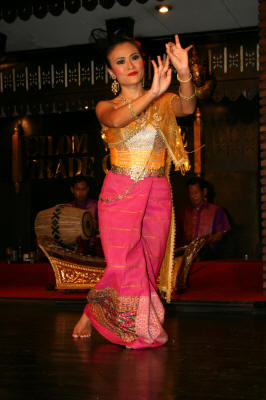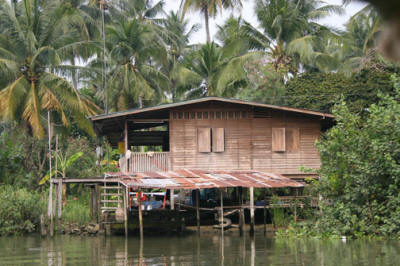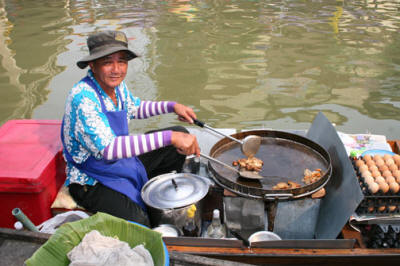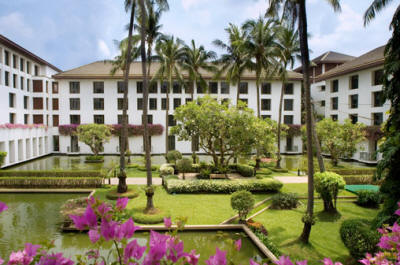|
Learn about Bangkok, Thailand, by reading
Escape to Paradise by Sandy Zimmerman, Travel Writer. It features
a mini, but thorough tour of the destination, plus all you'll need
to know to plan your trip including getting there, objective information
on places to stay and eat, and things to do. At the end of the article,
we've provided a summary of the contact information for your easy
reference. Enjoy!
Escape To Paradise-Bangkok, Thailand
by Sandy Zimmerman, Travel Writer and WTA Member

Classical Siamese dancing at Silom Village.
Photo courtesy of Sandy Zimmerman
Bangkok, the capital and largest urban area of Thailand, offers
an exotic setting to experience ancient customs while indulging
yourself in the finest restaurants, hotels, and spas. All of this
can be done at a fraction of the cost of what you‘d pay in the United
States. Located in the middle of Southeastern Asia, Thailand is
one of the world's top tourist destinations with a variety of things
to do that suit all interests. In 2006, Bangkok received the second
highest number of tourists in the world after London. Its influence
in the arts, politics, fashion, education, and entertainment, as
well as being the business, financial and cultural center of Asia
has given Bangkok the status of a global city. It is also the world's
22nd largest city by population with approximately 8,000,000 registered
residents.
The city boasts some of the country's most visited historical
venues such as the Grand Palace, Wat Pho, and Wat Arun. There are
a large number of palaces in Bangkok, several which are still in
use by the Thai royal family, while others are open to the public
and still others have become governmental buildings or universities.
The Grand Palace, which dates to 1782, is a complex of buildings
and was the king’s official residence. It served as the official
residence of Thailand's monarchs for over 150 years - from the 18th
century to the mid-20th century.
Wat Phra Kaew (Temple of the Emerald Buddha) is regarded as the
most sacred and important Buddhist temple (wat) in Thailand. It
houses the Emerald Buddha and is located within the grounds of the
Grand Palace. The construction of the temple started in 1785, and
unlike other temples, it doesn’t contain living quarters for monks
but highly decorated holy buildings, statues, and pagodas. The Emerald
Buddha is a statue of the sitting Buddha, made of green jade (rather
than emerald), approximately 18 feet tall and adorned with garments
made of gold. There are three different sets of gold clothing, which
are changed by the King in a ceremony at the changing of the seasons
-around March, July and November. The three sets of gold garments
correspond to Thailand's hot season, rainy season, and cool season.
The two sets of gold clothing not in use at any given time are kept
on display in the nearby Pavilion of Regalia, Royal Decorations
and Thai Coins on the grounds of the Grand Palace, where the public
may view them.
Wat Arun (Temple of the Dawn) is one of the most visited temples
in Bangkok. Perhaps so named because the first morning light is
reflected off the surface of the temple. The temple is located on
the west bank of the Chao Phraya River, rises 279 feet and is the
tallest structure in Bangkok.
Wat Pho (Temple of the Reclining Buddha) is directly adjacent
to the Grand Palace. It is the largest temple in Bangkok and named
for its huge reclining Buddha measuring 151 feet long and covered
in gold leaf. The Buddha's feet alone are 10 feet long. This temple
is also known as the birthplace of traditional Thai massage, which
is a type of massage that involves stretching and deep massage.
Bangkok is also home to the National Gallery of Thailand. It
exhibits collections of both traditional Thai and contemporary arts
by past and present famous artists of Thailand. Also found at the
National Gallery are the Bangkok Metropolitan Museum of Contemporary
Art, the Thailand Creative & Design Center (TCDC), the Thailand
Cultural Centre, the National Theatre, as well as many other museums,
concert halls, theatres, and art galleries.
Bangkok was laced with canals in the 19th century, giving the
capital the designation “Venice of the East”. Surviving canals and
the Chao Phraya River provide memorable vignettes of traditional
waterborne way-of-life that has remained essentially unchanged over
the centuries. The river and canals may be conveniently explored
by chartered boat or cruise. Riverine Bangkok offers some of the
capital’s most arresting sights, particularly at night when the
weather is cooler and reflections bestow the Chao Phraya River with
flickering lights.
Thailand has a variety of shopping experiences from street markets
to world class luxury malls. Tourists have historically always preferred
markets and bazaars to other forms of shopping. The Chatuchak weekend
market is one of the largest shopping destinations in Bangkok. Water
markets are gradually disappearing, but remain strong tourist attractions
as many tours are offered through the canals on which the markets
are located.
The city also hosts two major film festivals annually. The Bangkok
International Film Festival is an international film festival held
annually since 2003. In addition to film screenings, seminars, and
gala events, the Golden Kinnaree Awards are presented to the winning
films and filmmakers. The World Film Festival of Bangkok is the
second film festival held and its emphasis is predominantly on independent
films from mostly emerging directors.
Day Tours

Traditional houses are built on stilts along
the Chao Phraya River.
Photo courtesy of Sandy Zimmerman
A tour to Bangkok’s Floating Market is relaxing and thrilling
at the same time. Climb on a long-tailed boat to experience life
along the Chao Phraya River (“River of Kings”), because every turn
of the river brings exotic sights of old temples and traditional
wooden houses built on stilts. The river is busy with vendors paddling
their small boats to sell fruit, vegetables and flowers. The Floating
Market in Old Bangkok is so named because the boats float around
the waterfront cafes and shops, and some boats are floating kitchens
with food being cooked on small stoves.

A vendor prepares food to sell at the floating
market.
Photo courtesy of Sandy Zimmerman
Theme tours are very popular today, focusing on traveler’s special
interests. Stop for a cooking class at M.L. Puang Dinakara Royal
Exquisite Thai Culinary Center. It was founded in 1986 by the granddaughter
of M. L. Puang Dinakara, who was a chef to the king and his family.
Her culinary creations are unique interpretations of traditional
Thai dishes. You can learn to cook Thai cuisine, and also learn
some of the finest recipes of royalty. The class takes about two
hours and afterwards you can sit in the dining room to eat your
Thai cuisine feast.
Medical Tourism
The latest term “Medical Tourism” is defining a new reason to
travel. The Tria Integrative Wellness Spa
goes further than massages and treatments. They offer wellness programs
for the whole body to optimize client health and well-being. Whether
your wish is modern medicine or ancient disciplines, you can arrange
a consultation with a medical doctor, a naturopathic doctor, a chiropractor,
an acupuncturist, an Indian healer, a nutritionist and other health
practitioners. Perhaps learning meditation, yoga or pilates can
reduce your stress. Their programs include reflexology, hydrotherapy,
detoxification, life coaching, psychotherapy, and much more.
Ancient Customs and Classical Dances
Ruen Thep, in Silom Village (www.silomvillage.co.th),
presents Thai classical dances and brings ancient Siamese music
and dancing to Bangkok. All of the music, dances, and songs are
authentic and have been handed down throughout the ages. Performers,
dressed in their dazzling jeweled costumes, ornate headdresses and
theatrical masks, move to classical Thai music with grace and charm.
Journey back to the days of ancient Siam and watch sword fights
and learn stories of the people. Watch a classical Thai orchestra,
dressed in traditional costumes, play their ancient musical instruments,
not normally seen today. The Ruen Thep Thai classical dancers perform
twice nightly, inside the Silom Village Trade Center-the last traditional
Thai village on Silom Road. It consists of 15 teak houses and 3
buildings built in 1908.
Places to Stay

The gardens at the Sukhothai Hotel.
Photo courtesy of Sandy Zimmerman
Enter the five-star Sukhothai Hotel (www.sukhothai.com)
and see the true meaning of world-class luxury! The Sukhothai resembles
a palace in Thailand’s ancient Sukhothai Kingdom. Their ancient
frescos, objects d’art, reflection pools, and impressive pillars
all present a picture of the past. Silken fabrics adorn the furnishings,
wallpaper, and drapes. You will also see many members of the staff
wearing colorful traditional silk clothing. The sliding silk-lined
wooden curtains are a perfectly beautiful way to keep out the sunlight
when you want to sleep late. There is a telephone at each side of
the bed, on the desk and in the bathroom next to the oversized tub.
The plasma television swivels around (180 degrees) for viewing either
from the bedroom or living room. Light dimmers and air conditioning
control panels allow you to regulate each area of the suite. And
the grandest suite of them all, the Sukhothai Suite (2,132 square
feet), is known as the “Suite of Kings”. A long list of movie stars,
heads of state and other dignitaries have stayed there.
Choose from the Celadon Thai Restaurant, Colonnade buffet, or
La Scala Italian Restaurant. The leisure facilities include a health
club, a swimming pool, a shopping arcade, and squash and tennis
courts. New guests receive flowers when they arrive and best of
all the exchange rate (34 Baht = $1 US-October 2008) allows you
to savor these surroundings at more reasonable rates. Imagine how
far your dollars will go in Thailand!
A member of the Small Luxury Hotels of the World, the five-star
Lebua Hotel at State Tower (https://lebua.com/hotels/lebua-at-state-tower/), lives up to its
motto - “Life is not worth living unless it is simply exceptional”.
They provide exceptional amenities and services to make certain
that your life is essentially as it should be. With that attitude,
you know you will be treated like royalty. Even the message in the
elevator says, “You were born free, so break free from the expected,
indulge in the exceptional and experience genuine care”.
Everything about the Lebua Hotel expresses a feeling of luxury-from
the lobby to the restaurants, suites, banquet rooms and even cocktail
lounges. Those “extras” really count. With over 330 count linens,
silky feather Finesse bed mats, Bvlgari bath line amenities and
a shower head that makes your shower more like a spa treatment,
the Lebua Hotel seems more luxurious than hotels in the United States.
You can even have their Conde Nast accredited chefs cook in your
suite.
Details
Getting There
Thai Airways reaches 70 cities in five countries. Daily non-stop
flights are available from Los Angeles and New York City to Bangkok,
www.thaiairways.com
Tourist Information
Tourism Authority of Thailand (TAT),
www.tourismthailand.org
Entry Requirements
All travelers must have a valid passport and return or through
ticket. <mailto:info@sukhothai.com>
Notice: This information is current as
of November 2008. It is recommended that you contact the numbers,
and/or visit the websites above to determine any changes to the
information.
|